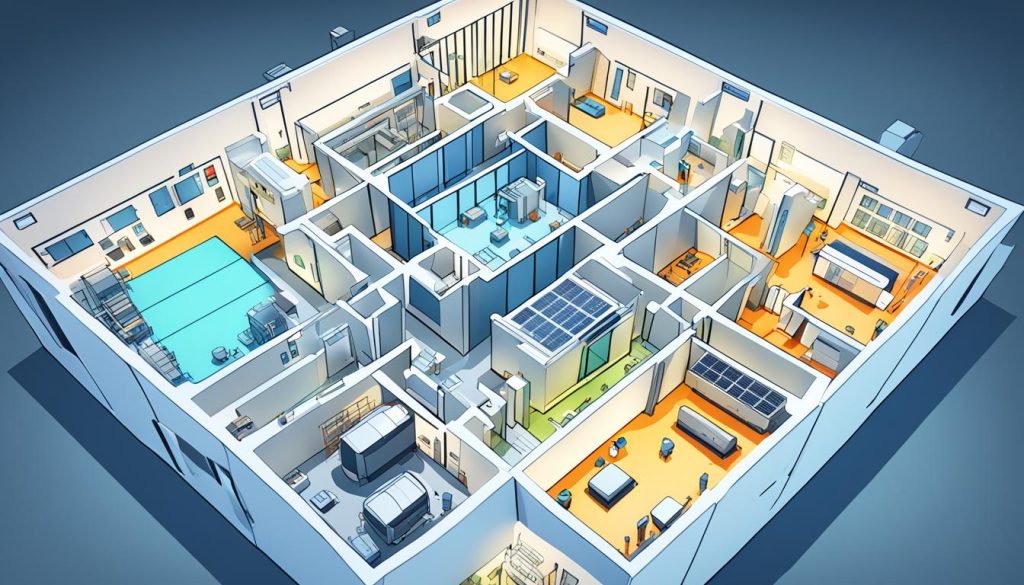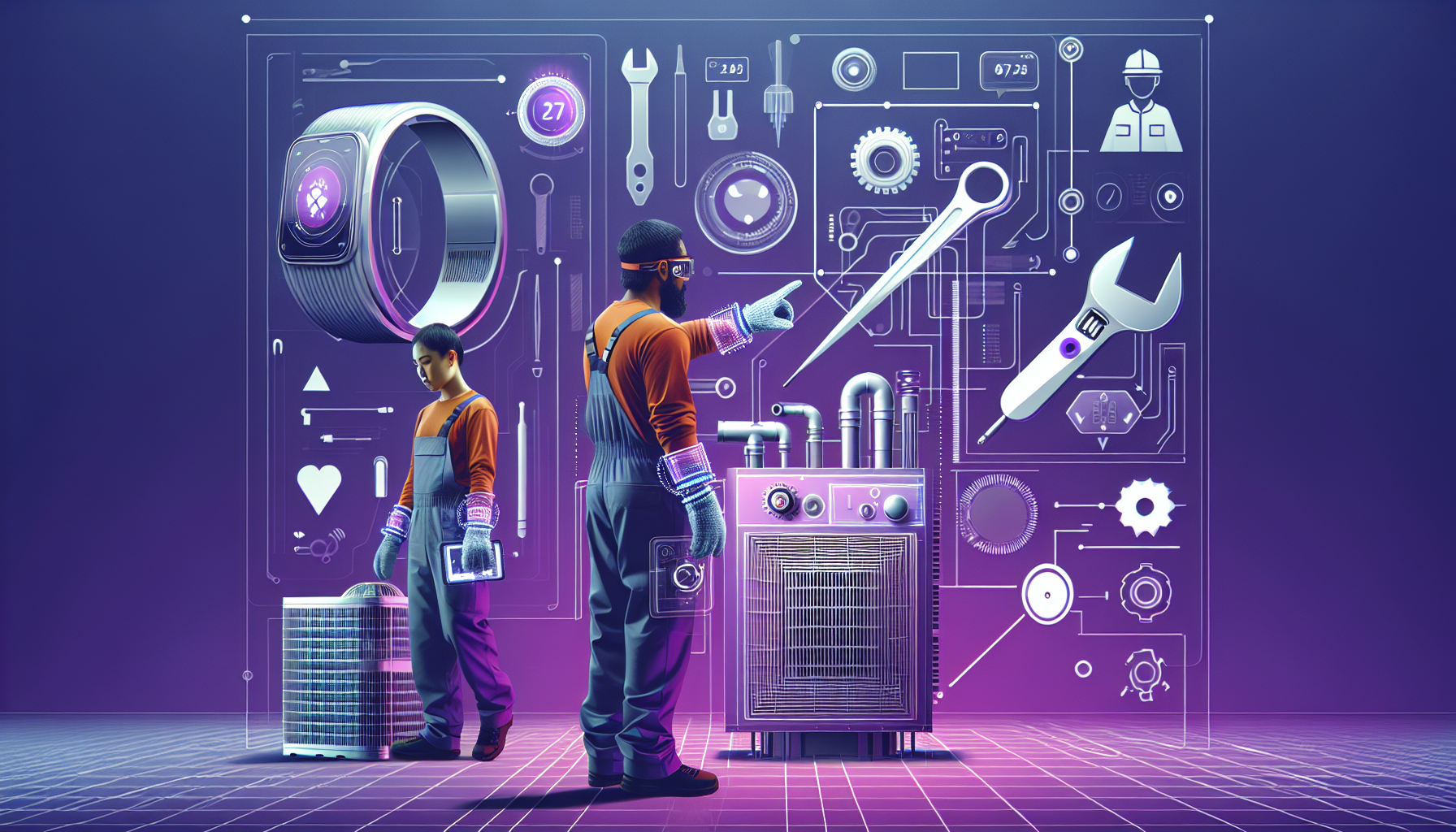Building Information Modeling (BIM) helps make HVAC systems more efficient by using 3D models and combining data. It lets you create detailed digital models of buildings and their systems. This makes it easier to work together, see designs, and analyze how well HVAC systems will work.
Using BIM in HVAC design means better system integration, finding clashes early, and making decisions based on data. This technology acts like a digital twin, giving you a full view of your project. It helps plan and optimize energy efficiency more accurately.
BIM changes HVAC design by making workflows smoother and improving team coordination. You can spot problems early, avoiding expensive fixes and delays later. With BIM, you can test different scenarios, check performance, and choose the best options. This leads to HVAC systems that are more sustainable and cost-effective.
Understanding BIM in HVAC Design
BIM technology is changing the HVAC industry. It’s a new way engineers design, plan, and manage building systems. Let’s look at what Building Information Modeling is and how it affects HVAC design.
What is Building Information Modeling?
Building Information Modeling is a digital method that makes virtual models of buildings. It’s more than just 3D modeling. It includes managing data and optimizing designs. With BIM, you can see the whole HVAC system before you start building.
Benefits of BIM for HVAC Projects
Using BIM for HVAC has many benefits:
- Improved teamwork
- Better accuracy in design and planning
- Fewer mistakes during installation
- More energy efficiency through simulations
- More accurate cost estimates and project management
Key Features of BIM Software for HVAC Design
BIM software has great tools for HVAC designers:
| Feature | Description |
|---|---|
| 3D Modeling | Create detailed visual representations of HVAC systems |
| Clash Detection | Find and fix conflicts between building parts |
| Performance Analysis | Simulate and improve HVAC system performance |
| Data Integration | Add equipment specs and building data |
| Collaboration Tools | Support real-time teamwork and sharing info |
These features help streamline your HVAC design process. They lead to better results for your projects.
Gathering Project Information for BIM Integration
Starting a successful HVAC system design with BIM means collecting all the project data you need. You must get building specs, occupancy info, and thermal needs for a precise model. This is key for planning and putting in HVAC systems well.
First, get the architectural drawings and work with architects to grasp the design goals. Ask about the building materials, insulation, and glazing. These details are crucial for the HVAC system’s thermal performance.
Then, gather info on how the building will be used and when. Knowing this helps figure out the HVAC system’s peak loads and zones.
| Project Information | Importance for HVAC Design |
|---|---|
| Architectural plans | Determines spatial layout and system placement |
| Building materials | Affects thermal insulation and heat transfer |
| Occupancy details | Influences load calculations and zoning |
| Thermal requirements | Guides equipment selection and sizing |
Last, note down the thermal needs for each space in the building. Think about temperature, humidity, and air quality standards. This makes sure your HVAC design fits each area’s specific needs.
Collecting all the project info early helps with a precise and efficient BIM-based HVAC design. This careful planning cuts down on mistakes and extra work, making the system work better overall.
Creating a Comprehensive 3D BIM Model
A detailed 3D model is key for designing HVAC systems well. With Building Information Modeling (BIM) software, you can make a virtual project model. It includes all important parts. This method helps with precise planning and optimizing your HVAC systems.
Accurate Architectural Representation
Begin by making a digital twin of your building’s design. Add walls, floors, ceilings, and openings to your 3D model. Having these architectural parts right helps spot areas that might lose or gain heat. This detail is crucial for figuring out heating and cooling needs.
Incorporating Structural Components
Then, add structural parts to your BIM model. Include beams, columns, and walls that carry weight. These parts affect where HVAC systems and ducts go. Adding them early helps avoid problems and makes better use of space.
Spatial Layout Optimization
Work on making the best spatial layout for HVAC planning. Plan out room setups, corridors, and open areas in your 3D model. This helps pick the best spots for HVAC gear and ducts. Making the layout work well means better air flow and less energy waste.
Creating a detailed 3D BIM model with the right architectural parts, structural elements, and layout makes a strong base for efficient HVAC design. This method leads to smarter choices and makes planning smoother.
Defining Thermal Zones in BIM
Thermal zoning is key in HVAC system design. It means dividing your building into areas with similar heat needs. This way, you get better HVAC control and save energy. Let’s see how to do this with Building Information Modeling (BIM).

Begin by looking at your building’s layout and how it’s used. Think about room orientation, sun exposure, and where heat comes from. Also, consider when different areas are used. For example, a conference room might need cooling when in use but not when it’s empty.
After spotting possible zones, use BIM to set up virtual boundaries. Give each zone its own heating and cooling needs. This approach ensures comfort and saves energy by avoiding waste.
| Zone Type | Characteristics | HVAC Considerations |
|---|---|---|
| Office Area | High occupancy, computer equipment | Balanced cooling, air filtration |
| Server Room | Heat-generating equipment, low occupancy | Constant cooling, humidity control |
| Lobby | Variable occupancy, large windows | Flexible heating/cooling, draft prevention |
Effective thermal zoning in BIM means smarter HVAC designs. By thinking about how people use each space, you can make a system that’s comfortable and efficient.
Performing Load Calculations with BIM Software
BIM software changes the game in HVAC load calculations. It combines building design with energy analysis tools. This mix leads to accurate equipment sizing and better system performance.
Incorporating Building Orientation and Insulation Factors
BIM tools consider building orientation and insulation levels. They calculate heat gain and loss. This helps figure out how sunlight and insulation affect HVAC needs.
You can tweak these factors to find the most energy-saving design.
Analyzing Glazing Properties and Climate Data
Glazing is key in HVAC load calculations. BIM software looks at window types, sizes, and spots to see their indoor temperature impact. It uses local climate data, including temperature and humidity changes, for accurate heating and cooling load estimates.
Determining Precise Heating and Cooling Requirements
BIM software combines all these elements for detailed HVAC load calculations. This info helps decide on the right equipment size. The outcome is an HVAC system that keeps people comfortable without wasting energy.
| BIM Feature | Impact on HVAC Design |
|---|---|
| 3D Modeling | Accurate spatial representation for precise load calculations |
| Energy Analysis | Optimized system performance and reduced energy waste |
| Climate Data Integration | Region-specific HVAC solutions for maximum efficiency |
Selecting HVAC Equipment Using BIM Analysis
BIM analysis changes how we pick HVAC equipment by using data. It lets you look at different options based on your project’s needs. You analyze load calculations and thermal zone needs to find the best fit for your building.

Choosing the right HVAC equipment is key, and energy efficiency ratings are a big part of that. BIM software lets you compare different models and their performance. This helps you pick systems that use less energy and save money over time.
It’s also important to think about system compatibility. BIM analysis makes sure all parts work well together, avoiding future problems. You can see how different units fit into the building, making sure they work well and are easy to maintain.
| Factor | BIM Analysis Benefit |
|---|---|
| Energy Efficiency | Compare ratings and predict long-term savings |
| System Compatibility | Ensure seamless integration of all components |
| Lifecycle Costs | Calculate total expenses including maintenance |
Looking at lifecycle costs is key for smart decisions. BIM analysis helps you see the upfront cost and long-term expenses. This includes maintenance, energy use, and replacement costs. By considering these, you can pick HVAC equipment that gives the best value over its life.
Improve System Design Efficiency with BIM
BIM changes the game in HVAC system optimization with its advanced tools. It helps you design better layouts, increase energy efficiency, and make your workflow smoother.
Optimizing System Layouts
BIM lets you see HVAC parts in 3D. This makes it easier to place them in the best spots, avoiding clashes and making better use of space. You can tweak ductwork and equipment positions for the most efficient setup.
Data-Driven Energy Efficiency
With BIM, you can make choices that boost energy efficiency. It looks at building data, climate info, and equipment specs to optimize system performance. This smart approach helps you pick the right equipment and size it correctly.
Streamlined Design Process
BIM makes designing easier by putting all building systems in one model. You can spot and fix conflicts between HVAC and other systems fast. This saves time, cuts down on mistakes, and leads to better project outcomes.
Using BIM for HVAC design means you’ll get more efficient systems, lower energy use, and top-notch results for your clients. The blend of data-driven design and advanced visualization makes BIM a key tool for HVAC pros today.
Simulating and Analyzing HVAC Performance in BIM
BIM software lets you test and analyze HVAC performance before installing it. This means you can check your design in a virtual world. By simulating HVAC performance, you can find and fix problems early.
Energy modeling is a big part of BIM for HVAC design. It shows how your system will work under different conditions. You can test your system in extreme heat or cold to see how it handles it. This helps make your designs more efficient and reliable.
Thermal comfort analysis is also key in BIM simulation. It checks how well your HVAC keeps the building at the right temperature. You can spot areas that are too hot or cold. Making these changes ensures everyone in the building stays comfortable.
The main aim of BIM simulation and analysis is system optimization. By testing different scenarios and comparing them, you can improve your HVAC design. This process balances energy use, comfort, and costs. The end result is an HVAC system that works great in real life.





0 Comments